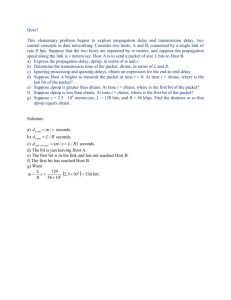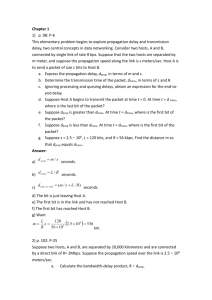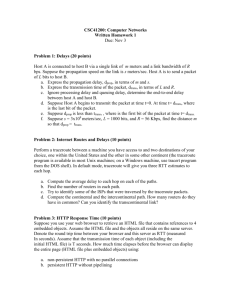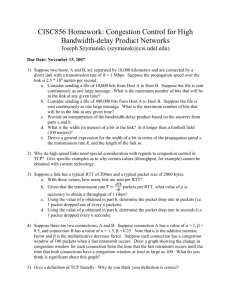Computer Networks Homework 1 Solution
advertisement
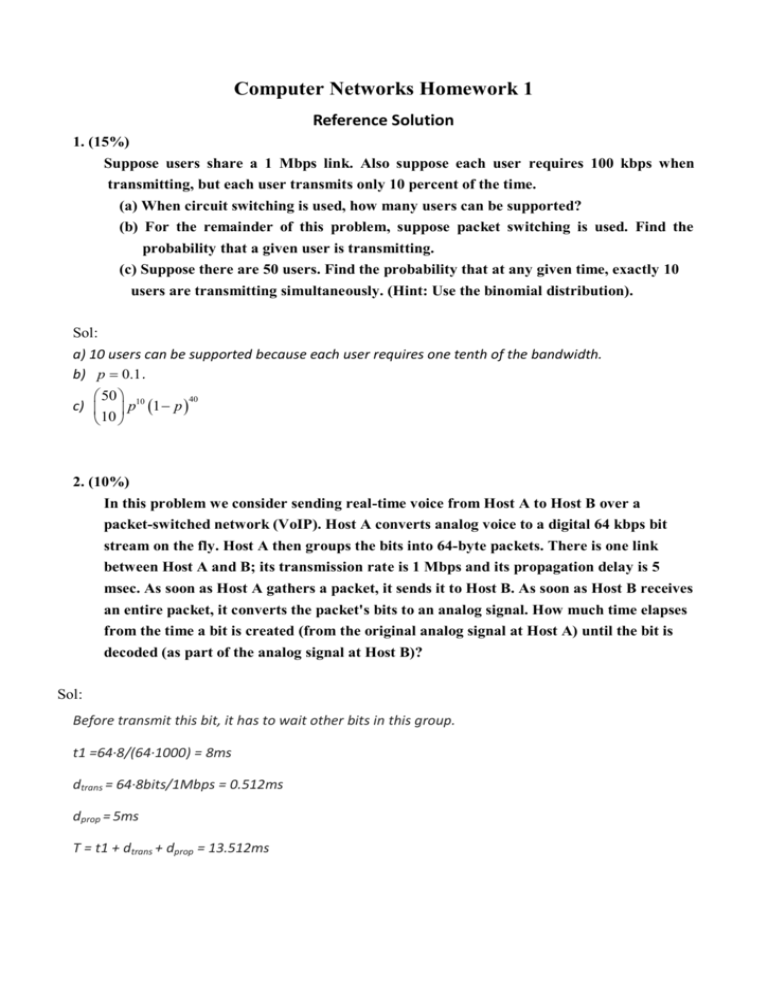
Computer Networks Homework 1 Reference Solution 1. (15%) Suppose users share a 1 Mbps link. Also suppose each user requires 100 kbps when transmitting, but each user transmits only 10 percent of the time. (a) When circuit switching is used, how many users can be supported? (b) For the remainder of this problem, suppose packet switching is used. Find the probability that a given user is transmitting. (c) Suppose there are 50 users. Find the probability that at any given time, exactly 10 users are transmitting simultaneously. (Hint: Use the binomial distribution). Sol: a) 10 users can be supported because each user requires one tenth of the bandwidth. b) p 0.1 . 50 40 c) p10 1 p 10 2. (10%) In this problem we consider sending real-time voice from Host A to Host B over a packet-switched network (VoIP). Host A converts analog voice to a digital 64 kbps bit stream on the fly. Host A then groups the bits into 64-byte packets. There is one link between Host A and B; its transmission rate is 1 Mbps and its propagation delay is 5 msec. As soon as Host A gathers a packet, it sends it to Host B. As soon as Host B receives an entire packet, it converts the packet's bits to an analog signal. How much time elapses from the time a bit is created (from the original analog signal at Host A) until the bit is decoded (as part of the analog signal at Host B)? Sol: Before transmit this bit, it has to wait other bits in this group. t1 =64∙8/(64∙1000) = 8ms dtrans = 64∙8bits/1Mbps = 0.512ms dprop = 5ms T = t1 + dtrans + dprop = 13.512ms 3. (15%) Suppose there is a 10 Mbps microwave link between a geostationary satellite and its base station on Earth. Every minute the satellite takes a digital photo and sends it to the base station. Assume a propagation speed of 2.4 ∙ 108 meters/sec. The distance between earth and geostationary satellite approach to 3.6 ∙ 107 m a. What is the propagation delay of the link? b. What is the bandwidth-delay product, R ∙ dprop ? c. Let x denote the size of the photo. What is the minimum value of x for the microwave link to be continuously transmitting? (a)dprop = 3.6∙107 / (2.4 ∙ 108) = 0.15 s (b) R ∙ dprop = 107 ∙ 0.15 = 1.5 ∙ 106 bits (c)X = 107 ∙ 60 = 6 ∙ 108 bits 4. (15%) Consider two hosts, A and B, connected by a single link of rate R bps. Suppose that the two hosts are separated by m meters, and suppose the propagation speed along the link is s meters/sec. Host A is to send a packet of size L bits to Host B. The transmission time of the packet is dtrans. The propagation delay is dprop. a) Suppose Host A begins to transmit the packet at time t = 0. At time t = dtrans, where is the last bit of the packet? b) Suppose dprop is greater than dtrans . At time t=dtrans, where is the first bit of the packet? c)Suppose dprop is less than dtrans . At time t = dtrans, where is the first bit of the packet? Sol: a) the bit is just leaving node A b)the first bit is in the link (it has not reached B yet) c) the first bit has reached B 5. (15%) Consider sending a packet of F bits over a path of Q links. Each link transmits at R bps. The network is lightly loaded so that there are no queueing delays. Propagation delay and processing delay are negligible. a) Suppose the network is a packet switched virtual circuit network. Denote the VC setup time by ts seconds. Suppose the sending layers add a total of h bits of header to the packet. How long does it take to send the file from source to destination? b) Suppose the network is a packet switched datagram network and a connectionless service is used. Now suppose each packet has 2h bits of header. How long does it take to send the packet? c) Finally, suppose that the network is a circuit-switched network. Further suppose that the transmission rate of the circuit between source and destination is R bps. Assuming t s setup time and and h bits of header appended to the packet, how long does it take to send the packet. Sol: (a) total time = ts + Q * (F + h)/R (b) total time = Q * (F + 2h)/R (c) total time = ts + (F + h)/R 6. (10%)Suppose within your web browser you click on a link to obtain a web page. The IP address for the associated URL is not cached in your local host, so a DNS look-up is necessary to obtain the IP address. Suppose that n DNS servers are visited before your host receives the IP address from DNS; the successive visits incur an RTT (Round Trip Time) of RTT1, ... RTTn. Further suppose that the web page associated with the link contains exactly one object, consisting of a small amount of HTTP text. Let RTT0 denote the RTT between the local host and the remote server containing the object. Assuming zero transmission time of the object, how much time elapses from when the client clicks on the link until the client receives the object? Sol: Time to visit DNS servers and get IP address = RTT1 + RTT2 + ... + RTTn Time to establish TCP connection (SYN and SYNACK) = RTT0 Time to send HTTP request and receive reply = RTT0 Total time = 2 * RTT0 + (RTT1 + RTT2 + ... + RTTn) 7.(10%). Consider an application that transmits data at a steady rate (for example, the sender generates an N-bit unit of data every k time units, where k is small and fixed). Also, when such an application starts, it will continue running for a relatively long period of time. Answer the following questions, briefly justifying your answer: (a)Would a packet-switched network or a circuit-switched network be more appropriate for this application? Why? (b)Suppose that a packet-switched network is used and the only traffic in this network comes from such applications as described above. Furthermore, assume that the sum of the application data rates is less than the capacities of each and every link. Is some form of congestion control needed? Why? Sol: a) A circuit-switched network would be well suited to the application described, because the application involves long sessions with predictable smooth bandwidth requirements. Since the transmission rate is known and not bursty, bandwidth can be reserved for each application session circuit with no significant waste. In addition, we need not worry greatly about the overhead costs of setting up and tearing down a circuit connection, which are amortized over the lengthy duration of a typical application session. b) Given such generous link capacities, the network needs no congestion control mechanism. In the worst (most potentially congested) case, all the applications simultaneously transmit over one or more particular network links. However, since each link offers sufficient bandwidth to handle the sum of all of the applications' data rates, no congestion (very little queuing) will occur. 8.(10%) In modern packet switched networks, the source host segments long application layer messages (for example an image or a music file) into smaller packets and sends the packets into the network. The receiver then reassembles the packets back into the original message. We refer to this process as message segmentation. Fig illustrates the end to end transport of a message with and without segmentation. Consider a msg that is 7.5x106 bits long that is to be sent from the source to the destination as shown in the figure. Suppose that each link in the figure is 1.5 Mbps. Ignore propagation, queuing and processing delays. a) consider sending the message from source to destination without message segmentation. How long does it take to move the message from the source host to the first packet switch? Keeping in mind that each packet switch uses a store and forward packet switching. What is the total time to move the message from the source host to the destination host? b) Now suppose that the message is segmented into 5,000 packets, with each packet being 1500 bits long. How long does it take to move the the first packet from the source host to the first packet switch? Sol a) Time to send message from source host to first packet switch = 7.5 × 106 / 1.5 × 106 sec = 5 sec . With store-and-forward switching, the total time to move 7.5 × 106 message from source host to destination host = 5 sec× 3 hops = 15 sec. b) Time to send 1st packet from source host to first packet switch = 1.5 × 10 3 / 1.5 × 106 sec = 1 msec. Time at which 2nd packet is received at the first switch = 2* (1.5 × 103 / 1.5 × 106) = 2 m sec. Time at which 1st packet is received at the second switch = 2 × 1 m sec = 2 m sec.
